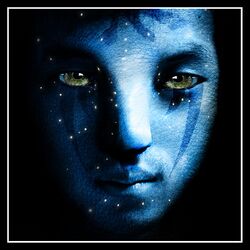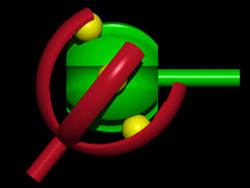Software:3D Movie
A 3D Movie is a computer file for a digital movie that uses Microsoft 3D Movie Maker or any of its expansions such as Doraemon 3DMM, Nickelodeon 3DMM, and v3DMM. 3D Movies can only be viewed in these products, and the creation of AVI or MPEG files from the 3D Movie file requires third-party software.[1] The two common file formats used by 3D Movies are .3mm and .vmm. .nmm was a third file format once used by 3D Movies, but since the release of the "Nickelodeon 3DMM" add-on to 3D Movie Maker, which combined both editions in one program, this has been deprecated by the ".3mm" file format.[2]
3D movie software is needed for motion pictures with depth, specifically two distinct images put together.[3] It originated from the 1920-1930's and went through times of people neglecting it, as it was first shot in a lower quality. It is also known as a stereoscopic to reiterate, a motion-picture narrative that ends up in three-dimensional standard with the use of film images.[4]
History

Introduced in the 1920s to the 1930s, 3D was technically poor. There were various problems with its color in film. This was problem solved by the Natural Vision way, which consists of utilizing a polarized lens, which in turn made it feasible to display the "convergence principle of the human eye in the filming".[5] The origin of 3D accommodated with Natural Vision, was shown by Bwana Devil. 3D decreased in its fame in Europe, as a society did not necessarily acquire a novelty of depth. But by the 1970s, a subtle fluctuation occurred.[5] The first public display of 3D film started in 1915, "when Edwin S Porter and William E Waddell showed an audience at New York City's Astor theatre".[1] Till 1950, 3D film did not have much fame. Because of good marketing, 3D film and technology were able to see the light. Phrases such as, "A lion is your lap! A lover in your arms!" sparked interest by the audience – this particular film made $2.5 million at its 1952 release at the American box office.[2] IMAX 3D was introduced in 1985, which showed transitions and immense computer animation by Roman Croitor, Colin Low, and Tony Ianzelo in We Are Born of Stars.[3] Cameras started to become made just for the purpose of 3D film. Robert Zemeckis' The Polar Express, reached above and beyond $300 million at the American box office, following that, Avatar by Cameron reached more than $2.7 billion, passing his own record for the "highest grossing film of all time", replacing Titanic. These movies were the rise of 3D and 2D film successes to further arrive.[4]
3D Movie Software Competitors
This section has multiple issues. Please help improve it or discuss these issues on the talk page. (Learn how and when to remove these template messages)
(Learn how and when to remove this template message)
|
1) Blender
8.8/10 ☆[6]
Blender is below the GNU General Public License, and a 3D creative suite including: "modeling, rigging, animation, simulation, rendering, compositing and motion tracking, video editing and 2D animation pipeline."[6]
2) SketchUp
8.3/10 ☆[6]
SketchUp is a software that bases on 3D modeling," with an emphasis on usability".[6]
3) Autodesk Maya
9.0/10 ☆[6]
In the Autodesk suite, Maya is given. Maya is a 3D software that utilizes, "modeling, simulation and rendering tool available to artists, animators, and educators."[6]
4) Adobe After Effects
8.8/10 ☆[6]
Adobe After Effects is a balance of complicated 3D software and easy software. It allows a nice range of usability, and results in "mid-level production".[6]
5) Autodesk 3ds Max
8.4/10 ☆[6]
In the Autodesk suite, 3ds Max is given which consists of: 3D modeling, rendering, "design visualization, games, and animation."[6] This software results in high professional content.
6) Zbrush
8.6/10 ☆[6]
Zbrush is a software that is best used to make 3d objects. It includes a user's personally made brushes or premade brushes. This software is utilized for "3D modeling, sculpting, and painting."[6]
7) ARSKAN Silodata
7/10 ☆[6]
Arskan is an editing software for 3D models. It is appealing with its texture and animation details.[6]
8) Geomagic
10/10 ☆[6]
Geomagic, often used in industries, is part of the product design suite. Things like 3D modeling as well as product manufacturing.[6] can result from this.
General Features of Sufficient 3D Software
Proficient 3D modeling services include a formation of a 3D image, with adequate arrangement. Further, the model should be able to be printed with set parameters. In the beginning of usage, or any part of the process in editing, users should be able to follow a demonstration of how the object they will create will work.[7]

In particular a firm component library is necessary, as it can add to speed and accuracy in a project, since it consists of sub-libraries of tools users need to create models. Next, a strong animation function set can help design and test things like keyframes easily. In settings where collaborations are a must, good software should have features that allow users to catch-up and work together remotely. This especially helps employees from other fields such as, architecture and engineering to add their insights on a company project.[8]
More Notable 3D Films
- Gravity (2013) – Included 3D space graphics, "floating oxygen cords and rocketing debris".[9] It earned on Oscar, and was a 3D Blockbuster.[9]
- How To Train Your Dragon (2010) – Included 3D motion with fictional Pixar characters, in specific the dragon's "aerial swooping and glidding".[9]
- Toy Story 3 (2010) – Included perspective of "toys that live" in the human society, and 3D motion of them.[9]
- The Nightmare Before Christmas 3D (2006) – 13 years afterwards the original film, the stop motion got modified with 3D. This version shows the characters being more interactive in motion.[9]
- Monsters Vs. Aliens (2009) – Included "real-sized looking" monsters on screens.[9]
- Coraline (2009) – The film was set in a goth theme, and there were portals that people could "almost reach out and touch".[9]
- Up (2009) – Appealing 3D animation that was symbolic and that also lead to emotions in audience.[9]
- Cloudy With A Chance Of Meatballs (2009) – Converted from computer graphic animation to 3D, with easy effort but effective in audience reactions.[9]
- Spider-Man: Into The Spider-Verse (2018) – Hand drawn 3D efforts, making Miles Morales' (spider-man), move across the screen quite literally.[9]
References
- ↑ 1.0 1.1 "3D video, 3D file extension,3D film". http://www.iorgsoft.com/glossary/3d.html.
- ↑ 2.0 2.1 "This Insane Rack Made Out Of 53 GoPros Captures 3D Movies" (in en-US). 17 February 2016. https://social.techcrunch.com/2016/02/17/this-insane-rack-made-out-of-53-gopros-captures-3d-movies/.
- ↑ 3.0 3.1 Albert, Melissa. "3-D | motion-picture process | Britannica" (in en). https://www.britannica.com/technology/3-D.
- ↑ 4.0 4.1 4.2 Albert, Melissa. "3-D | motion-picture process | Britannica" (in en). https://www.britannica.com/technology/3-D.
- ↑ 5.0 5.1 Albert, Melissa. "DreamWorks Animation | History, Movies, TV Shows, & Facts | Britannica" (in en). https://www.britannica.com/topic/DreamWorks-Animation.
- ↑ 6.00 6.01 6.02 6.03 6.04 6.05 6.06 6.07 6.08 6.09 6.10 6.11 6.12 6.13 6.14 6.15 "Cinema 4D Competitors and Alternatives". TrustRadius. https://www.trustradius.com/products/cinema-4d/competitors.
- ↑ "Main Features of 3D Modeling | Aristek Systems" (in en). https://aristeksystems.com/blog/features-of-3d-modeling/.
- ↑ "Top Features of 3D Modeling Software | TEC" (in en). https://www3.technologyevaluation.com/research/article/top-features-of-3d-modeling-software.html.
- ↑ 9.0 9.1 9.2 9.3 9.4 9.5 9.6 9.7 9.8 9.9 "The 20 best 3D movies". https://www.empireonline.com/movies/features/best-3d-movies/.
 |

